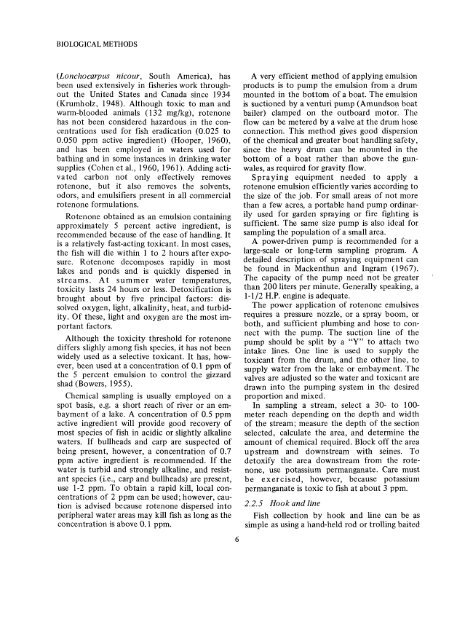Biological field and laboratory methods for measuring the quality of ...
Biological field and laboratory methods for measuring the quality of ...
Biological field and laboratory methods for measuring the quality of ...
Create successful ePaper yourself
Turn your PDF publications into a flip-book with our unique Google optimized e-Paper software.
BIOLOGICAL METHODS<br />
(Lonchocarpus nicour, South America), has<br />
been used extensively in fisheries work throughout<br />
<strong>the</strong> United States <strong>and</strong> Canada since 1934<br />
(Krumholz, 1948). Although toxic to man <strong>and</strong><br />
warm-blooded animals (132 mg1kg), rotenone<br />
has not been considered hazardous in <strong>the</strong> concentrations<br />
used <strong>for</strong> fish eradication (0.025 to<br />
0.050 ppm active ingredient) (Hooper, 1960),<br />
<strong>and</strong> has been employed in waters used <strong>for</strong><br />
bathing <strong>and</strong> in some instances in drinking water<br />
supplies (Cohen et aI., 1960, 1961). Adding activated<br />
carbon not only effectively removes<br />
rotenone, but it also removes <strong>the</strong> solvents,<br />
odors, <strong>and</strong> emulsifiers present in all commercial<br />
rotenone <strong>for</strong>mulations.<br />
Rotenone obtained as an emulsion containing<br />
approximately 5 percent active ingredient, is<br />
recommended because <strong>of</strong> <strong>the</strong> ease <strong>of</strong> h<strong>and</strong>ling. It<br />
is a relatively fast-acting toxicant. In most cases,<br />
<strong>the</strong> fish will die within 1 to 2 hours after exposure.<br />
Rotenone decomposes rapidly in most<br />
lakes <strong>and</strong> ponds <strong>and</strong> is quickly dispersed in<br />
streams. At summer water temperatures,<br />
toxicity lasts 24 hours or less. Detoxification is<br />
brought about by five principal factors: dissolved<br />
oxygen, light, alkalinity, heat, <strong>and</strong> turbidity.<br />
Of <strong>the</strong>se, light <strong>and</strong> oxygen are <strong>the</strong> most important<br />
factors.<br />
Although <strong>the</strong> toxicity threshold <strong>for</strong> rotenone<br />
differs slighly among fish species, it has not been<br />
widely used as a selective toxicant. It has, however,<br />
been used at a concentration <strong>of</strong> 0.1 ppm <strong>of</strong><br />
<strong>the</strong> 5 percent emulsion to control <strong>the</strong> gizzard<br />
shad (Bowers, 1955).<br />
Chemical sampling is usually employed on a<br />
spot basis, e.g. a short reach <strong>of</strong> river or an embayment<br />
<strong>of</strong> a lake. A concentration <strong>of</strong> 0.5 ppm<br />
active ingredient will provide good recovery <strong>of</strong><br />
most species <strong>of</strong> fish in acidic or slightly alkaline<br />
waters. If bullheads <strong>and</strong> carp are suspected <strong>of</strong><br />
being present, however, a concentration <strong>of</strong> 0.7<br />
ppm active ingredient is recommended. If <strong>the</strong><br />
water is turbid <strong>and</strong> strongly alkaline, <strong>and</strong> resistant<br />
species (i.e., carp <strong>and</strong> bullheads) are present,<br />
use 1-2 ppm. To obtain a rapid kill, local concentrations<br />
<strong>of</strong> 2 ppm can be used; however, caution<br />
is advised because rotenone dispersed into<br />
peripheral water areas may kill fish as long as <strong>the</strong><br />
concentration is above 0.1 ppm.<br />
6<br />
A very efficient method <strong>of</strong> applying emulsion<br />
products is to pump <strong>the</strong> emulsion from a drum<br />
mounted in <strong>the</strong> bottom <strong>of</strong> a boat. The emulsion<br />
is suctioned by a venturi pump (Amundson boat<br />
bailer) clamped on <strong>the</strong> outboard motor. The<br />
flow can be metered by a valve at <strong>the</strong> drum hose<br />
connection. This method gives good dispersion<br />
<strong>of</strong> <strong>the</strong> chemical <strong>and</strong> greater boat h<strong>and</strong>ling safety,<br />
since <strong>the</strong> heavy drum can be mounted in <strong>the</strong><br />
bottom <strong>of</strong> a boat ra<strong>the</strong>r than above <strong>the</strong> gunwales,<br />
as required <strong>for</strong> gravity flow.<br />
Spraying equipment needed to apply a<br />
rotenone emulsion efficiently varies according to<br />
<strong>the</strong> size <strong>of</strong> <strong>the</strong> job. For small areas <strong>of</strong> not more<br />
than a few acres, a portable h<strong>and</strong> pump ordinarily<br />
used <strong>for</strong> garden spraying or fire fighting is<br />
sufficient. The same size pump is also ideal <strong>for</strong><br />
sampling <strong>the</strong> population <strong>of</strong> a small area.<br />
A power-driven pump is recommended <strong>for</strong> a<br />
large-scale or long-term sampling program. A<br />
detailed description <strong>of</strong> spraying equipment can<br />
be found in Mackenthun <strong>and</strong> Ingram (1967).<br />
The capacity <strong>of</strong> <strong>the</strong> pump need not be greater<br />
than 200 liters per minute. Generally speaking, a<br />
1-1/2 H.P. engine is adequate.<br />
The power application <strong>of</strong> rotenone emulsives<br />
requires a pressure nozzle, or a spray boom, or<br />
both, <strong>and</strong> sufficient plumbing <strong>and</strong> hose to connect<br />
with <strong>the</strong> pump. The suction line <strong>of</strong> <strong>the</strong><br />
pump should be split by a "Y" to attach two<br />
intake lines. One line is used to supply <strong>the</strong><br />
toxicant from <strong>the</strong> drum, <strong>and</strong> <strong>the</strong> o<strong>the</strong>r line, to<br />
supply water from <strong>the</strong> lake or embayment. The<br />
valves are adjusted so <strong>the</strong> water <strong>and</strong> toxicant are<br />
drawn into <strong>the</strong> pumping system in <strong>the</strong> desired<br />
proportion <strong>and</strong> mixed.<br />
In sampling a stream, select a 30- to 100meter<br />
reach depending on <strong>the</strong> depth <strong>and</strong> width<br />
<strong>of</strong> <strong>the</strong> stream; measure <strong>the</strong> depth <strong>of</strong> <strong>the</strong> section<br />
selected, calculate <strong>the</strong> area, <strong>and</strong> determine <strong>the</strong><br />
amount <strong>of</strong> chemical required. Block <strong>of</strong>f <strong>the</strong> area<br />
upstream <strong>and</strong> downstream with seines. To<br />
detoxify <strong>the</strong> area downstream from <strong>the</strong> rotenone,<br />
use potassium permanganate. Care must<br />
be exercised, however, because potassium<br />
permanganate is toxic to fish at about 3 ppm.<br />
2.2.5 Hook <strong>and</strong> line<br />
Fish collection by hook <strong>and</strong> line can be as<br />
simple as using a h<strong>and</strong>-held rod or trolling baited















